Sydney
Dr Martin Parkinson | Secretary to the Treasury | 07 March 2012
It is a pleasure to be here with you today.
This is the second AICC event I have spoken at in the last year, a year of global dislocation and change, with financial turmoil emanating from the North Atlantic and the still unfolding implications of upheaval in the Middle East.
In the 12 months since I became Treasury Secretary I've delivered a range of presentations around the country. But while the venues have been different, there have been 3 recurring themes.
Global and domestic transformation
First, the world is changing in terms of countries' respective economic weight and, hence, geo-political importance. This transformation is most obvious in the rapid growth and increased global economic importance of the two Indo-Pacific giants, China and India, but it extends far beyond our region, to countries such as Brazil, Turkey, Mexico, Nigeria, and, closer to home, Indonesia and Vietnam.
It is this transformation that has lifted hundreds of millions of people from poverty in recent decades, and has seen low- and middle-income countries increase in importance to half of global GDP and be expected to contribute around three-quarters of global GDP growth over the next five years.
Chart 1: Global transformation underway since 1980s
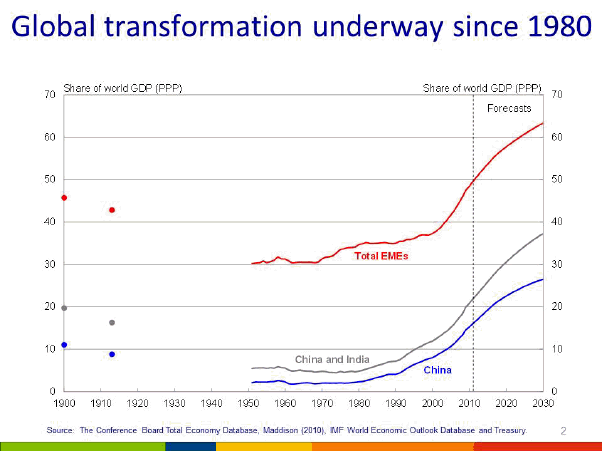
Source: The Conference Board Total Economy Database, Maddison (2010), IMF World Economic Outlook Database and Treasury
But the forces leading to this global transformation are also remaking the Australian economy. This adjustment within our economy is causing difficulty for some sectors and is even leading to a questioning of the post-1983 suite of policies that has delivered huge growth in our own living standards and an improved resilience in our economy.
Chart 2: National income (GDI per capita)
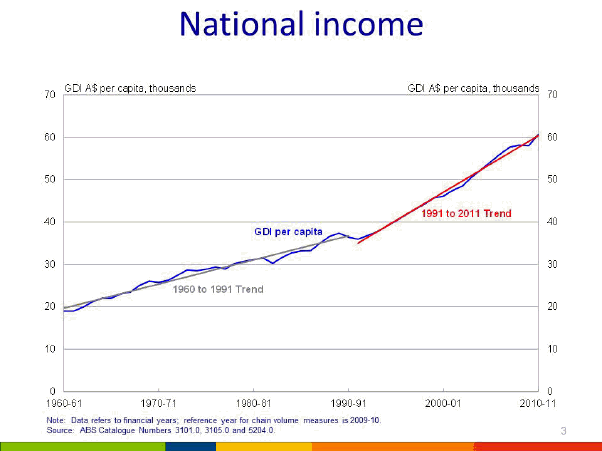
This new world brings with it huge opportunities for Australia, particularly on the back of the growth in the Asia-Pacific (excluding the United States and Canada) middle class which is expected to grow from around 500 million people in 2009, to around 1.7 billion by 2020 and to 3.2 billion by 2030. This group of people will want knowledge intensive manufactures, knowledge intensive services – health, education and professional services, everything from legal and architectural skills to logistical know-how – higher quality diets and great tourism experiences.
If we continue to make the right policy choices, as we showed ourselves capable of in the 1980s and 1990s, we have the opportunity to underpin Australia's future prosperity and establish ourselves as an exemplar for the rest of the world. The decisions we made during that previous period of restructuring have contributed to the living standards we enjoy today, and the decisions we make today will determine our prospects for the years ahead.
To put it simply, Australian policy reform in the face of past structural pressures has raised Australian living standards dramatically. To take one example, the Productivity Commission has estimated that productivity improvements and price changes observed over the 1990s in key infrastructure sectors affected by National Competition Policy and related reforms boosted Australia's GDP by around 2.5 per cent. This means our economy today is around $35 billion larger than it would have been without those reforms.
Australia's governments have previously committed themselves to reducing the impact of regulation on the cost of doing business and to promote competition as part of reforms to achieve a Seamless National Economy. The Productivity Commission's preliminary assessment of 17 of the Seamless National Economy deregulation reforms is that, if completed, these could increase GDP by over 0.4 per cent in the longer run, growing the economy by over $6 billion in today's dollars.
In contrast, had we failed to take the hard choices in the past decade, and pursued populist policies – whether regulatory or fiscal – that reduced competition, undermined price signals and distorted resource allocation, we would have consigned Australia to lower productivity and lower living standards today.
As a nation, we face the same choices again – do we continue to pursue pro-market, pro-competition, pro-productivity reforms – using the benefits of the mining boom to help grasp the opportunities of the global transformation, or do we complacently try to slide through on our natural resource endowment alone while watching the huge opportunities from the growing Asian middle class melt away?
An aging population and a deteriorating productivity performance
Second, we continue to face the pre-existing domestic challenges of an aging population and a decade long decline in our productivity performance. Coincidentally, there is significant overlap in the policies required to address these challenges and those required if we are to grasp the global opportunities, potentially offering huge co-benefits from the same set of actions.
Notwithstanding the attention that the GFC and its aftermath have demanded from policy makers at all levels of government, we cannot lose sight of the fact that our population is aging – the data are well known. In 2010, 11.7 per cent of our population was aged between 65 and 84, and 1.8 per cent were aged 85 and over. By 2050, the comparable figures are 17.6 per cent of Australia's population aged between 65 and 84, and 5.1 per cent aged 85 and over. In percentage terms these may not seem large changes – but it means that we could have over 8 million people aged 65 and over by 2050, of whom 1.8 million people will be at least 85.
Put another way, rather than the 5 people of traditional working age we had for each person aged 65 and over in 2010, we will have around 2.7 by 2050. As the intergenerational reports have noted, this carries with it big challenges for fiscal sustainability and an imperative to improve productivity in the caring sectors, especially health and aged care.
The challenge to turn around our deteriorating productivity performance more generally is also well known – after the significant improvements in productivity flowing from the post 1983 reforms, the beginning of the 2000s saw a marked slowing in labour productivity growth. More disturbing still has been the sharp deterioration in multi-factor productivity – how clever we are at combining labour, capital, resources and ideas.
Chart 3: Productivity growth cycles
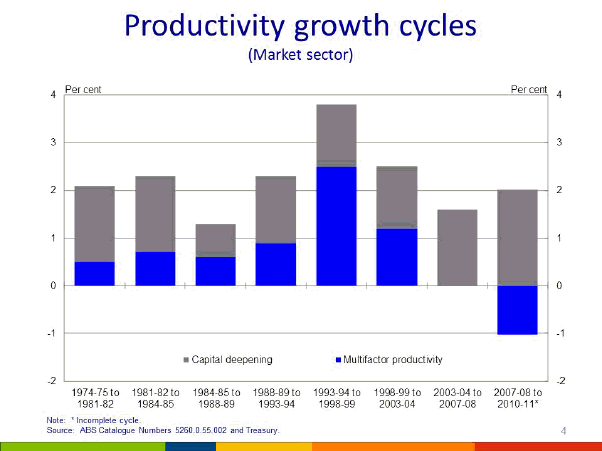
It is true that the growth in mining investment is dampening these figures as we are yet to see the resulting growth in output, and we are increasingly pursuing lower-quality resource deposits, but the story remains, albeit somewhat muted, even if we abstract from mining.
As Paul Krugman has so pithily put it: "Productivity isn't everything, but in the long run it is almost everything. A country's ability to improve its standard of living over time depends almost entirely on its ability to raise its output per worker."
Chart 4: Decomposition of growth in real GNI per capita
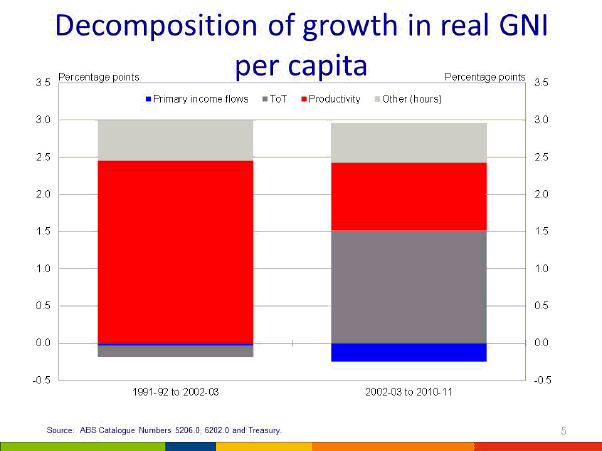
This is particularly germane to Australia today. After almost all of our growth in national income coming from productivity in the 1
990s and early 2000s, over the last decade the contribution from productivity has more than halved – we have maintained the same rate of growth in living standards only because of the huge rise in our terms of trade. If, as we suspect, the terms of trade are unlikely to grow much, if at all, from here, this means that growth in Australian living standards will also slow unless productivity picks-up.
Some of the investments now being made to improve productivity – especially those in infrastructure and skills – will have a significant payoff in the years ahead. But there are some things that can have a more immediate payoff – while we wait for new skills and training to flow through the workforce we should be doing everything possible to ensure existing skills are able to be effectively utilised. For this reason it is imperative that we accelerate implementation of the Seamless National Economy initiatives, including on skill recognition across state boundaries.
Medium-term fiscal strategy and the importance of fiscal credibility
Third, the recent experience in Europe, and to a lesser extent, the United States, highlights the importance of a credible medium-term approach to fiscal policy.
In recent decades, Australia has been well served by a bi-partisan commitment to sustainable public finances. The willingness of Australian Governments to build up fiscal reservoirs in the good times and to deploy those resources when needed to help sustain the economy, as we saw during the Global Financial Crisis (GFC), has contributed much to the stability of the economy in the last two decades.1
Critically, having deployed our fiscal ammunition during the GFC, the imperative today is to return to surplus and to pay down debt – to begin to recharge our fiscal ammunition for future use if needed, and to ensure that fiscal policy plays its part in delivering macro-economic stability in stronger economic circumstances.
That said, the task of maintaining medium-term sustainability for both the Commonwealth and the States has been made harder by developments in the revenue base. Indeed, for both levels of government, surpluses are likely to remain at best razor-thin without deliberate efforts to significantly increase revenue or reduce expenditure.
This predominantly reflects the sharp weakening of revenue collections over recent years.
The tax-to-GDP ratio has fallen by 4 percentage points since the GFC, and is not expected to recover to its pre-crisis level for many years to come. This reflects a combination of cyclical and structural factors. Capital gains tax has been hit hard in the aftermath of the crisis. Households are more cautious in their spending pattern, dampening indirect taxes in the process. Meanwhile, the resources boom and the increasing importance of the mining sector is having significant impact on tax revenues. Mining companies account for about a fifth of gross operating surplus, yet only around a tenth of company tax receipts, primarily because tax receipts from the industry are affected by the high levels of investment occurring in the sector and the consequent level of depreciation deductions. Finally, the historically high Australian dollar hurts profits in, and taxes from, the non-mining export, and import-competing, sectors.
Chart 5: Tax receipts and total payments to GDP since the mid-1980s
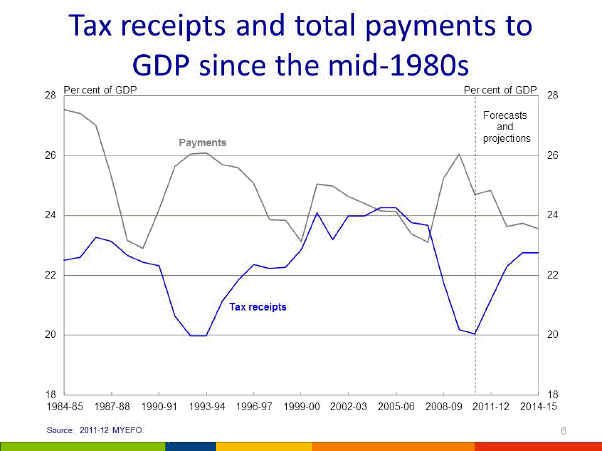
With muted growth in tax receipts projected for much of the next decade, Australia will need significantly greater expenditure restraint in the decade ahead than was seen in the first half of the 2000s if we are to deliver the sort of fiscal outcomes likely to be required for sound macroeconomic management and as we pay down debt.
At the same time, there is an emerging debate about the desirability of a Sovereign Wealth Fund. Putting aside the fact we already have an SWF (the Future Fund), the conflicting objectives of the different proponents of a new SWF, and whether our superannuation system already has some of the characteristics sought in a new Fund, it is worth making a fairly straightforward observation.
Specifically, Treasury is often characterised as being opposed to an SWF – yet our comments are neither supportive nor critical. Rather, we continue to observe that the creation of an SWF per se does nothing to address either Australia's net debt position or, more broadly, the level of government or national savings over time.
If the Australian Government had financial liabilities of $10 billion and runs a $1 billion surplus, it can reduce gross liabilities to $9 billion, or it can maintain them at $10 billion and buy $1 billion of financial assets to be held in an SWF – in both cases, net financial liabilities are $9 billion.
The only way the creation of a Sovereign Wealth Fund delivers a faster improvement in net debt is if it is used to justify a tightening of fiscal policy that would not otherwise be achieved.
As such, if we are to have a sensible discussion about the merits of an SWF, the proponents of such Funds, whether at the national or sub-national level, need to be clearer about precisely what they have in mind. Absent tough fiscal decisions, an SWF does not constitute a contribution to future fiscal sustainability.
Conclusion
I hope these brief comments have given a little more clarity to some of the things my colleagues and I have been saying over the last year regarding the key challenges confronting Australia.
Thank you.
1 This is not to suggest that policy has been appropriately calibrated at all times, but rather that fiscal policy has tended to lean against the state of the economy at most times since the mid 1980s.